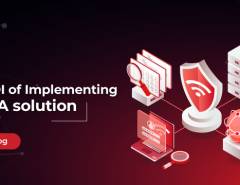Reports released by CSO suggest that cybersecurity threats are expected to amplify up to a staggering $6 trillion, by the end of 2021. This revelation validates the fact that security threats are looming large and majority of global businesses are constantly combating their advances, in order to keep the confidential information safe and secure. While 2017 came across as a rough year for the cybersecurity experts, 2018 isn’t expected to be any different with reports presuming a rise in the number of cybercrimes. Therefore, individuals and organizations must have some New Year resolutions in place for keeping these attacks at bay. As businesses, we must join hands and pledge that 2018 will aim at protecting confidential data of the subjects while maintaining compliance with the existing cybersecurity regulations.
Educating the Users and Employees
The first thing one should focus on is to educate the massive chunk of Internet users regarding the proliferating threats. Industries must look to arrange cybersecurity training workshops for their employees, in order to educate them about the rise of cyber attacks.
Opting for Two-Factor Authentication
Every individual or organization must at least opt for a 2FA approach to cybersecurity. While we always prefer four-factor authentication for highly confidential data, two-factor authentication should be the bare minimum, going into 2018.
Applying Machine Learning
Machine learning should form the crux of any organizational cybersecurity strategy in 2018. Applying the basics of machine learning to a security plan renders additional levels of competence, thereby simplifying the entire process of identifying potential attacks. Opting for a more humane approach that concerns sifting through logs and numerous alerts can be extremely arduous and time-consuming, especially when the organization is dealing with corporate clients.
Focusing on Threat Prevention
2017 witnessed several organizations trying to cure the infected databases. However, the results weren’t convincing enough as companies had to compromise a lot, going into 2018. Therefore, 2018 should be all about preventing the attacks from occurring in the first place. While individuals must opt for highly secured passwords and authentication techniques, companies must look to include multi-layered security strategies, involving data encryption and obfuscation.
Achieving GDPR Compliance
Although the General Data Protection Regulation covers the European Union, the ramifications and implications aren’t restricted to a particular demographic. Every organization bracing the global entrepreneurial stage must be prepared to abide by the GDPR guidelines in 2018. As this regulatory implementation aims at securing the customer data, GDPR compliance should come as an important cybersecurity resolution for 2018.
Engaging and Empowering the Employees
Companies, in 2018, must realize the truth behind security and its implementation. Engaging the employees is the biggest industrial challenge and when combined with empowerment, comes across as a powerful cybersecurity tool. It must be realized that security is more of a journey and less of a destination which is indicative of the fact that employees must show up as the major cyber defenders for an organization.
Setting Schedules
Companies must make sure that schedules are set on a periodic basis in order to assess and secure the confidential data sets. There are times when organizations fail to schedule important updates; thereby compromising the safety of devices. Complacency and procrastination are the major cybersecurity abominations and there must be stringent schedules in place for keeping them at a fair distance.
Battling Insecure Authentications
IoT will assume gigantic proportions in 2018 and it’s appropriate that organizations protect themselves from the insecure authentications. Most importantly, companies that are restructuring their enterprise architecture should be extra careful as new IoT threats might emerge as frequently as the older ones.
Testing Backups
Most of the affected firms in 2017 failed to identify their backup systems prior to encountering threats. 2018 will surely be all about testing the backups which companies can fall back upon, when and if the existing systems get compromised.
Achieving Zero Alerts Concerning False Positives
Eliminating false positives should be the prime focus of every organization, going into the future. Reducing calculative errors by drafting functional and automated incident response plans is a great technique to deploy artificial intelligence and keep false positive alerts at bay.
Once bitten, twice shy must be the approach adopted by companies in 2018. As 2017 saw widespread attacks on global organizations, we must be all decked up with strategies for combating the threats in 2018.
As an IT security partner for your business, Seqrite provides comprehensive endpoint security from advanced cyber threats. To know more, visit our website or




